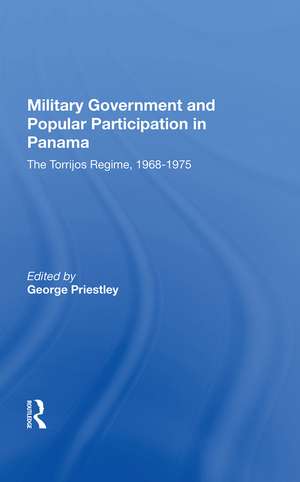Military Government And Popular Participation In Panama: The Torrijos Regime, 1968-1975
Autor George Priestleyen Limba Engleză Hardback – 7 iun 2019
Preț: 222.32 lei
Preț vechi: 273.74 lei
-19% Nou
Puncte Express: 333
Preț estimativ în valută:
42.55€ • 46.24$ • 35.77£
42.55€ • 46.24$ • 35.77£
Carte tipărită la comandă
Livrare economică 21 aprilie-05 mai
Preluare comenzi: 021 569.72.76
Specificații
ISBN-13: 9780367008772
ISBN-10: 0367008777
Pagini: 176
Dimensiuni: 147 x 229 mm
Greutate: 0.45 kg
Ediția:1
Editura: Taylor & Francis
Colecția Routledge
Locul publicării:Oxford, United Kingdom
ISBN-10: 0367008777
Pagini: 176
Dimensiuni: 147 x 229 mm
Greutate: 0.45 kg
Ediția:1
Editura: Taylor & Francis
Colecția Routledge
Locul publicării:Oxford, United Kingdom
Cuprins
Westview Special Studies -- Introduction -- The 1960s Crisis of Hegemony and the Emergence of the Torrijos Regime -- Demobilization and Incorporation of a Shanty Community: The Case of San Miguelito -- The Politics of Agricultural Reform -- Institutionalization of the Revolution: A New National Constitutional Structure -- Local Participatory Structures: The Community Boards -- Conclusion -- Appendixes -- Distribution of Work Force -- Growth Index of the Work Force (1960-1975) -- Number of Peasant Settlements and Families Organized Per Province (1969-1972) -- Government Credit to Peasant Settlements (1970-1972) -- Council of State by Name, Office, Profession, and Country of Study (1977) -- National Legislative Commission Members by Name, Profession, and Country of Study (1977) -- Joint Chiefs of Staff by Rank, Name, Division, and Training Profile (1975)
Descriere
This study details the formation of a populist alliance by the Panamanian military in order to legitimize its leadership and restructure the rules of the political process. Along with the move for popular support, the Torrijos regime introduced an economic strategy based on export-oriented industrialization. The shift toward such policies by General Omar Torrijos Herrera, whose ideologies and political strategies were “neither the left nor the right,” bewildered and confused many in Panama and the United States, especially groups accustomed to having their vested interests coincide with those of the Panamanian military. The lessons drawn from this study illustrate an alternative to exclusionary and repressive military regimes in Central America.
